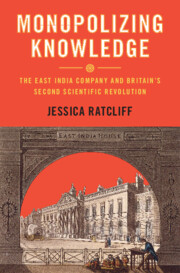Refine search
Actions for selected content:
13575 results in History of science and technology
Preface
-
- Book:
- Worldmaking and Cuneiform Antiquity
- Published online:
- 09 January 2025
- Print publication:
- 09 January 2025, pp ix-xii
-
- Chapter
- Export citation
7 - Imago Mundi
- from Part II - Worldmaking and the Anthropology of Science
-
- Book:
- Worldmaking and Cuneiform Antiquity
- Published online:
- 09 January 2025
- Print publication:
- 09 January 2025, pp 198-211
-
- Chapter
- Export citation
Part II - Worldmaking and the Anthropology of Science
-
- Book:
- Worldmaking and Cuneiform Antiquity
- Published online:
- 09 January 2025
- Print publication:
- 09 January 2025, pp 103-214
-
- Chapter
- Export citation
Introduction
-
- Book:
- Worldmaking and Cuneiform Antiquity
- Published online:
- 09 January 2025
- Print publication:
- 09 January 2025, pp 1-28
-
- Chapter
- Export citation
5 - Uses of Diversity
- from Part II - Worldmaking and the Anthropology of Science
-
- Book:
- Worldmaking and Cuneiform Antiquity
- Published online:
- 09 January 2025
- Print publication:
- 09 January 2025, pp 133-167
-
- Chapter
- Export citation
Figures
-
- Book:
- Worldmaking and Cuneiform Antiquity
- Published online:
- 09 January 2025
- Print publication:
- 09 January 2025, pp viii-viii
-
- Chapter
- Export citation
Acknowledgments
-
- Book:
- Worldmaking and Cuneiform Antiquity
- Published online:
- 09 January 2025
- Print publication:
- 09 January 2025, pp xiii-xiv
-
- Chapter
- Export citation
Index of Names and Subjects
-
- Book:
- Worldmaking and Cuneiform Antiquity
- Published online:
- 09 January 2025
- Print publication:
- 09 January 2025, pp 249-256
-
- Chapter
- Export citation

Monopolizing Knowledge
- The East India Company and Britain's Second Scientific Revolution
-
- Published online:
- 02 January 2025
- Print publication:
- 16 January 2025
Nima Bassiri, Madness and Enterprise: Psychiatry, Economic Reason, and the Emergence of Pathological Value Chicago: University of Chicago Press, 2024. Pp. 344. ISBN 978-0-226-83089-6. $35.00 (paper).
-
- Journal:
- The British Journal for the History of Science , First View
- Published online by Cambridge University Press:
- 26 December 2024, pp. 1-2
-
- Article
-
- You have access
- HTML
- Export citation
Nuno Vila-Santa, Knowledge Exchanges between Portugal and Europe: Maritime Diplomacy, Espionage, and Nautical Science in the Early Modern World (15th–17th Centuries) Amsterdam: Amsterdam University Press, 2024. Pp. 372. ISBN 978-90-485-6047-9. €141.00 (hardback).
-
- Journal:
- The British Journal for the History of Science , First View
- Published online by Cambridge University Press:
- 20 December 2024, pp. 1-2
-
- Article
-
- You have access
- HTML
- Export citation
Guillaume Carnino, Liliane Hilaire-Perez and Jérôme Lamy (eds.),Global History of Techniques: 19th–21st Centuries Turnhout: Brepols, 2024. Pp. 781. ISBN 978-2-503-59151-3. €120.00 (hardback).
-
- Journal:
- The British Journal for the History of Science , First View
- Published online by Cambridge University Press:
- 19 December 2024, pp. 1-2
-
- Article
-
- You have access
- HTML
- Export citation
Aaron Bateman, Weapons in Space: Technology, Politics, and the Rise and Fall of the Strategic Defense Initiative Cambridge, MA: MIT Press, 2024. Pp. 336. ISBN 978-0-262-54736-9. $60.00 (paperback).
-
- Journal:
- The British Journal for the History of Science , First View
- Published online by Cambridge University Press:
- 19 December 2024, pp. 1-2
-
- Article
-
- You have access
- HTML
- Export citation
Index
-
- Book:
- The Architectural Image and Early Modern Science
- Published online:
- 29 November 2024
- Print publication:
- 19 December 2024, pp 451-462
-
- Chapter
- Export citation
Select Bibliography
-
- Book:
- The Architectural Image and Early Modern Science
- Published online:
- 29 November 2024
- Print publication:
- 19 December 2024, pp 418-450
-
- Chapter
- Export citation
Michael Batty, The Computable City: Histories, Technologies, Stories, Predictions Cambridge, MA: MIT Press, 2024. Pp. 544. ISBN 978-0-262-54757-4. $45.00 (paperback).
-
- Journal:
- The British Journal for the History of Science , First View
- Published online by Cambridge University Press:
- 19 December 2024, pp. 1-2
-
- Article
-
- You have access
- HTML
- Export citation
Three - Drafting the Architectura: Drawing as Research in Art, Architecture, and Science
-
- Book:
- The Architectural Image and Early Modern Science
- Published online:
- 29 November 2024
- Print publication:
- 19 December 2024, pp 169-238
-
- Chapter
- Export citation
Contents
-
- Book:
- The Architectural Image and Early Modern Science
- Published online:
- 29 November 2024
- Print publication:
- 19 December 2024, pp vii-viii
-
- Chapter
- Export citation
Five - Dissecting the Architectura: Anatomy, Ornament, and the Limits of Figuration
-
- Book:
- The Architectural Image and Early Modern Science
- Published online:
- 29 November 2024
- Print publication:
- 19 December 2024, pp 297-346
-
- Chapter
- Export citation
Copyright page
-
- Book:
- The Architectural Image and Early Modern Science
- Published online:
- 29 November 2024
- Print publication:
- 19 December 2024, pp iv-iv
-
- Chapter
- Export citation
